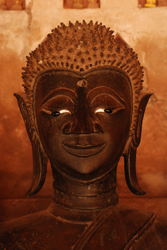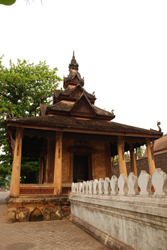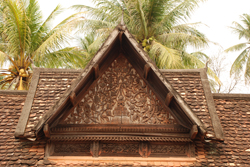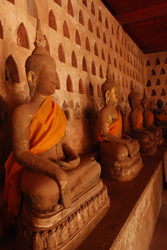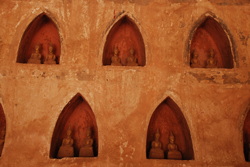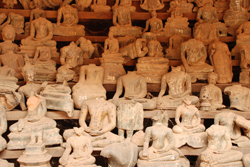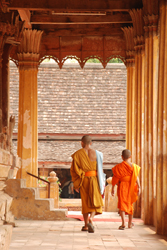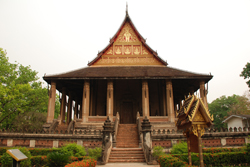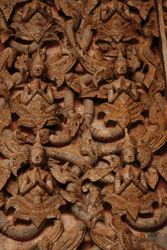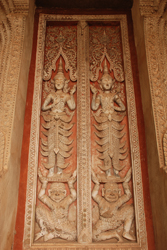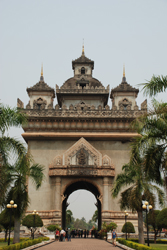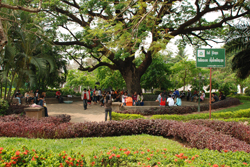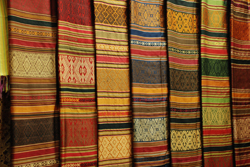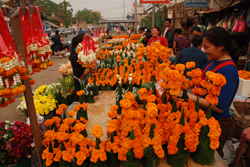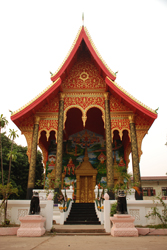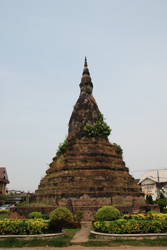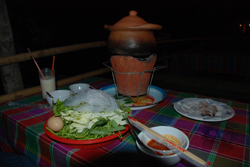The Sights of Vientiane
17 March, 2009, 03:39 am in "Laos"
We've been affected by Lao tropical lethargy. Today was hot and humid. We had to move slowly.Wat Sisaket was built between 1818-1824 by King Anou, the last King of Vientiane.
It was the only wat not destroyed by the Siamese invasion in 1827-28. Therefor is the oldest surviving wat in Vientiane.
It was the only wat not destroyed by the Siamese invasion in 1827-28. Therefor is the oldest surviving wat in Vientiane.
It is a humble looking wooden building when compared to the newer wats. The paint has almost all weathered off leaving the ornate wood carved trim a simple brown. Around the wat was a covered passage. The wall of the passage was full of little niches, each containing two little Buddha statues. A note said there were 6,840 total. In the sim, the main building of the wat, there were more niches containing 2,052 statues. The passage contained larger Buddha statues as well, 120 of them. The note said there was a total of 10,136 statues in the wat. The facial features were sharper and more pronounced than the Buddhas I'd seen in other places giving them an almost avian look.
The roofs of the buildings were shingled with clay tiles blackened by lichen and moss. Between 2 sections of the colonnades was a small open storage room full of Buddha statues. A sign stated the Buddhas had been damaged,decapitated, partially melted or otherwise damaged by fires and attacks from the end of the 19th century. Some were found underground during excavations of Vientiane.
The courtyard was lined with pots of flowers. Beyond the walls palm trees rose. Inside the sim were paintings illustrating Balasaukhya Jataka which told the story of Prince Pookkharabat who “chose an honest thief as his chief minister and who defeated his enemies with a magic fan.” There were also scenes of court life, battles and the qualities needed to be a successful ruler. The ceiling was decorated with gold moldings representing lotus flowers.
Across the street is Wat Phra Keo. The original was built in 1565 by King Xaisethathirath who ruled the Lao Lanexang Kingdom. It was built to house the emerald Buddha which was captured by the Siamese in 1779 and has been in Bangkok ever since. The wat had some beautiful sculpted reliefs and floral trim around the doors and windows.
The interior served a dual purpose as museum and place of worship. People prayed in front of a large Buddha while behind them were urns, Buddhas and other consecrated items in display cases or arranged around the walls. Some had offerings placed in/on them. In front of the wat were some stones with sanskrit engravings and divided circle figures, maybe mandalas. The grounds had trimmed lawns and flowers making it a pretty and relaxing place.
The other day we visited Patuxay which is an unfinished triumphal arch built in the 60s from concrete donated by the US to built a runway.
It was Sunday and people sat at tables in the shade of the arch. Teens and young adults hung out in the shade of a large tree next to the fountain. Photographers with photo printers powered by batteries carried in their back packs, wandered the area looking for customers.
The other day we visited Patuxay which is an unfinished triumphal arch built in the 60s from concrete donated by the US to built a runway.
It was Sunday and people sat at tables in the shade of the arch. Teens and young adults hung out in the shade of a large tree next to the fountain. Photographers with photo printers powered by batteries carried in their back packs, wandered the area looking for customers.
Talat Sao, the morning market is a great place to look for handcrafts. I love Lao design. They use beautiful color combinations and interesting tasteful patterns. The silk pieces are beautiful. The shop owners take a lot of care in arranging their wares in an attractive manner as well.
The Ban Anou market was more of a local market with food and flower offerings. We also stopped by a wat. The sun glowed through the haze like the last burning ember of a fire. It remained as if caught in the branches of a tree like a piece of fruit. The wat was slender and tall with columns like palm trunks and a roof like an arrow to the heavens.
The Black Stupa was supposed to protect the city from invasion. It didn't work so has been left to languish in a small intersection.
Last night Rowshan and I had Lao BBQ which is a clay brazier with pot of boiling broth where you cook stuff they give you. We ordered seafood. A plate of shrimp and squid (I think) arrived with a basket with lots of greens-- mint, cilantro, bok choi (cabbage), and other herbs, cellophane noodles and an egg. They also gave us some Lao BBQ sauce. We'd seen someone cooking and eating it the night before. It seemed fairly straight forward. We threw the seafood in first and waited a bit. Then we added noodles and some greens and the egg. It seemed to work fine, although I think we overcooked the seafood. We enjoyed our meal. A Lao couple was at the table next to us. Rowshan had checked with them if we were doing things right. They also had a hot-pot. They told us during the rainy season the water comes up to where the restaurants are and last year covered the road.
Comments
- Comments
Powered by My Blog 1.69. Copyright 2003-2006 FuzzyMonkey.net.
Created by the scripting wizards at FuzzyMonkey.net..
(Code modified by Rowshan Dowlatabadi)
Created by the scripting wizards at FuzzyMonkey.net..
(Code modified by Rowshan Dowlatabadi)


